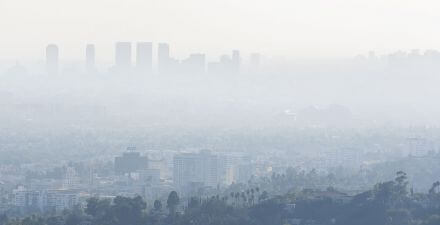Excessive heat harms U.S. workers unequally as the safety risks from climate change soar

This summer’s West Coast heat waves come as no surprise. But headlines about the various negative effects of excessive heat, including fatal wildfires, often overlook the plight of everyday workers. Extreme heat due to the effects of climate change threaten the health and safety of predominantly non-college-educated U.S. workers, especially young men in their early prime-age working years, according to new research published today in the Washington Center for Equitable Growth’s Working Paper series.
The new working paper by Jisung Park and Nora Pankratz at the University of California, Los Angeles and A. Patrick Behrer at Stanford University documents, for the first time, the growing safety risks of excessive heat for U.S. workers in occupations not just where the work is mostly outside but also indoors. It examines confidential data from California’s worker compensation system, the nation’s largest, finding that on days with highs of 90 degrees Fahrenheit, workplace injuries increase by 6 percent to 9 percent, compared to a day in the 50–60-degree F temperature range, while days of 100 F or higher increase injuries by 10 percent to 15 percent.
All told, the three co-authors estimate that hotter temperatures caused approximately 260,000 to 450,000 additional unreported heat related injuries in California over the period between 2001–2018, or roughly 15,000 to 25,000 per year. They estimate the socioeconomic costs of these injuries are on the order of $525 million to $875 million per year, given the costs of healthcare, lost wages and productivity, and other knock-on costs such as work disruptions and potential permanent disability. And that toll will be registered unequally as climate change hits men without a college degree hardest and as the reverberations of the coronavirus pandemic continue to harm front-line, mostly low-income workers, particularly workers of color.
Indeed, the health and economic toll from this summer’s record-breaking heat waves in the West could well elevate these numbers and costs in California and across the entire U.S. economy. And certainly, the rapidity of climate change makes it important to understand the consequence of heat exposure on working conditions, particularly the 70 percent of the 100 million U.S. workers without a bachelor’s degree who report routine exposure to harsh environmental conditions on the job. The coronavirus pandemic spotlights further the importance of nonwage compensation for U.S. workers in the form of enhanced workplace safety.
Climate change, worker safety, and U.S. income and health inequality
Research shows human physical and cognitive performance to be highly sensitive to heat. But little is known about how climate change will affect workers, particularly in the United States and other developed economies.
This latest research by Park, Pankratz, and Behrer presents important new evidence. Using administrative data from worker’s compensation claims in 1,700 ZIP codes across California, and then linking these records to high-frequency local weather data, they were able to isolate the causal impact of a hotter day on the number of injury claims in a given ZIP code, as well as location-specific seasonality.
In order to account for the possibility that increased injuries are driven by firms working employees for longer hours or recruiting more workers to make up for lost time, they separately estimate the effect of temperature on the number of workers and worker-hours on the job and find that the results are unlikely to be driven by these factors. They find that hotter temperatures increase workplace accidents in both indoor and outdoor settings and for many injury types not directly related to heat, such as falling from heights, being struck by a moving vehicle, or mishandling dangerous machinery.
As one might expect, hotter temperatures significantly increase injuries in predominantly outdoor industries, such as agriculture, utilities, and construction. But higher temperatures also increase injuries in some industries where work typically occurs indoors. In manufacturing, for instance, a day with highs above 95 degrees Fahrenheit increases injury risk by approximately 7 percent, relative to a day in the low-60s F. In wholesale, the effect is nearly 10 percent.
These patterns are consistent with recent research that finds hotter temperature to adversely affect cognitive performance and decision-making, as well as the possibility that firms must manage costs on hotter days by reducing safety investment, all of which provides evidence that leveraging investments in workplace safety is good for firms and the broader economy.
What’s more, the three co-authors find that heat exposure at work may exacerbate recent trends in workplace inequality. Because lower-wage workers are more likely to work in dangerous occupations, more likely to live and work in places with greater heat exposure, and experience larger marginal increases in risk on hotter days, the net effect on injuries is far greater for low-income groups. They find that for California workers in the bottom 20 percent ZIP-code-level residential income, the annual effect is approximately five times larger than for someone in the top 20 percent of the residential income distribution.
Park, Pankratz, and Behrer’s findings also present age and gender inequalities related to the threats to health from excessive heat. The effect of heat on injuries is significantly larger for men relative to women and for younger workers relative to older ones. Men appear to be at least three times more affected by heat-related workplace safety risks, compared to women, and workers in their 20s and 30s are approximately two times more affected than those in their 50s and 60s.
The implications of this research on policymaking
These findings suggest that many of the documented injuries may be preventable using existing technologies. The data suggest there is significant potential for adaptation to climate-related workplace risks. The effect of a day hotter than 90 degrees Fahrenheit on worker safety falls by roughly a third between 2001 and 2018, and the effect of days above 100 F is statistically indistinguishable from zero after 2005, which coincides with the introduction of what was, at the time, the nation’s first heat safety mandate, the California Heat Illness Prevention Standard, which applied only to outdoor workplaces.
More research is needed to understand whether such policies can improve safety without adversely affecting wages and employment, but the evidence is consistent with the notion that, even in some of the hottest parts of the world, measures can be taken to reduce heat-related worker risks. For instance, we document a significant decline in heat sensitivity of injuries even in the hottest third of California’s extreme heat distribution (by average number of days above 95 F), which corresponds to the 95th percentile of the U.S. extreme heat distribution.
Yet climate change may already be adversely affecting U.S. workers in ways that official statistics may have significantly undercounted to date and which may exacerbate economic inequality in ways not fully captured by headline wage statistics. This year may well break the 2020 record that tied 2017 as the hottest year on record. Projections suggest that parts of the United States will experience more than 50 additional days above 90 F by 2040 to 2050 alone.
This means that, without further protections, many thousands of workers may face dangerously hot working conditions in coming years due to climate change. Research shows that the economic costs of rising health shocks could be substantial, leading to future earnings losses and even leading in some cases to more bankruptcies. For instance, a recent study finds that Americans who are hospitalized experience average earnings losses of 17 percent over the ensuing years, even those who have health insurance. Another recent study estimates that each workplace injury results in direct and indirect economic losses of approximately $35,000 per injury (in 2020 dollars).
Because many exposed workers have lower levels of formal education, these climate impacts may exacerbate trends in economic inequality. At the same time, because worker’s compensation and health insurance only cover a fraction of the total costs, the burden is not shared by all members of society. Estimates suggest that workers compensation covers less than 25 percent of the total economic burden associated with workplace accidents.
For those who do not have health insurance, such shocks to health have been shown to significantly increase the risk of bankruptcy. This may compound the challenges faced by noncollege workers amid the coronavirus pandemic, which has been shown to hit low-wage, low-education workers hardest.
What policymakers can do to protect U.S. workers from extreme heat
Federal regulations do not provide workplace protections against extreme heat. There are no binding regulations at the federal level, with the U.S. Occupational Safety and Health Administration providing only general guidelines pertaining to heat safety but no binding statutes. In October 2020, then-Sen. Kamala Harris (D-CA) and Sen. Sherrod Brown (D-OH) introduced a bill that would extend California’s protections nationwide. But those protections apply only to outside workers. Given the extent of these new findings on workplace safety needs due to excessive heat for indoor workers, state and federal policymakers should consider implementing binding safety standards related to heat for all U.S. workers.






